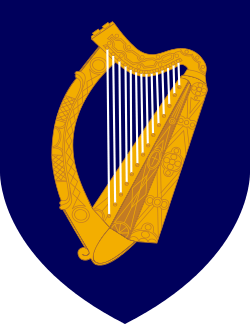Minister of State (Ireland)
A Minister of State (Irish: Aire Stáit) in Ireland (also called a junior minister) is of non-cabinet rank attached to one or more Departments of State of the Government of Ireland and assists a Minister of that Government.
 |
|---|
| This article is part of a series on the politics and government of the Republic of Ireland |
|
Administrative geography |
Appointment
Unlike senior government ministers which are appointed by the President of Ireland on the advice of the Taoiseach and the prior approval of Dáil Éireann, Ministers of State are appointed directly by the government, on the nomination of the Taoiseach. Members of either House of the Oireachtas (Dáil or Seanad) may be appointed to be a Minister of State at a Department of State; to date, the only Senator appointed as Minister of State has been Pippa Hackett, who was appointed in June 2020 to the Government of the 33rd Dáil. Ministers of State continue in office after the dissolution of the Dáil until a successor is appointed. If the Taoiseach resigns from office, a Minister of State is also deemed to have resigned from office.[1]
Powers and duties of a Government Minister may be delegated to a Minister of State by a statutory instrument.[2] If the Government Minister resigns, these powers must delegated again on the appointment of a new Government Minister.[3] Some Ministers of State are de facto department heads. In the 31st Government, Leo Varadkar was the Minister for Defence but the day-to-day running of the department was done by Paul Kehoe, the Minister of State at the Department of Defence.
History
The Ministers and Secretaries Act 1924 allowed the Executive Council (from 1937, the Government of Ireland) to appoint up to seven Parliamentary Secretaries to the Executive Council or to Executive Ministers.[4] This position was abolished by the Ministers and Secretaries (Amendment) (No. 2) Act 1977, which created the new position of Minister of State.[5] This Act was commenced on 1 January 1978.[6]
In the 1977 Act, the number of Ministers of State was limited to 10. In 1980 this was raised to 15, in 1995 it was raised to 17, and in 2007 it was raised to 20. On 21 April 2009, Brian Cowen asked all 20 Ministers of State to resign, and he re-appointed a reduced number of 15 ministers the following day, when the Dáil resumed after the Easter recess.[7][8] As of April 2020, there are 19 Ministers of State.
Máire Geoghegan-Quinn was the first woman to be appointed as a Parliamentary Secretary, when she was appointed as Parliamentary Secretary to the Minister for Industry and Commerce by Jack Lynch in 1977 (becoming Minister of State at the Department of Industry, Commerce and Energy in 1978). In 1979, Geoghegan-Quinn would become the first women appointed to cabinet since 1921.
Super Junior
The Minister of State at the Department of the Taoiseach is the Government Chief Whip and the most senior Minister of State, and attends cabinet. The Chief Whip is Jack Chambers.
Since the Rainbow Coalition formed in 1994, several governments have appointed additional Ministers of State with permission to attend cabinet but not vote thereat. Ministers of State attending cabinet, other than the Chief Whip, are usually described as a "Super Junior" minister.[9] Ministers of State attending cabinet in the 32nd Government are:
- Jack Chambers, Government Chief Whip and Minister of State for the Gaeltacht and Sport
- Hildegarde Naughton, Minister for International Travel & Logistics, Department of Climate Action, Communication Networks & Transport
- Pippa Hackett, Minister for Land Use & Biodiversity, Department of Agriculture
See also
References
- "Ministers and Secretaries (Amendment) (No. 2) Act 1977, Section 1: Appointment of Ministers of State". Irish Statute Book. 6 December 1977. Retrieved 20 April 2020.
- "Ministers and Secretaries (Amendment) (No. 2) Act 1977, SIs made under the Act". Irish Statute Book. 6 December 1977. Retrieved 20 April 2020.
- "Ministers and Secretaries (Amendment) (No. 2) Act 1977, Section 2: Delegation of powers and duties of Ministers of the Government to Ministers of State". Irish Statute Book. 6 December 1977. Retrieved 20 April 2020.
- "Ministers and Secretaries Act 1924, Section 7: Power to Executive Council to appoint Parliamentary Secretaries". Irish Statute Book. 21 April 1924. Retrieved 20 April 2020.
- "Ministers and Secretaries (Amendment) (No. 2) Act 1977, Section 6: Repeals". Irish Statute Book. 6 December 1977. Retrieved 20 April 2020.
- "Ministers and Secretaries (Amendment) (No. 2) Act 1977 (Commencement) Order 1977". Irish Statute Book. 13 December 1977. Retrieved 20 April 2020.
- "Number of junior ministers to be cut". RTÉ News. 6 April 2009. Retrieved 6 April 2009.
- "Two new junior ministers revealed". RTÉ News. 22 April 2009. Retrieved 23 April 2009.
- "No changes for Noonan and Howlin in reshuffle". RTÉ News. 15 July 2014.